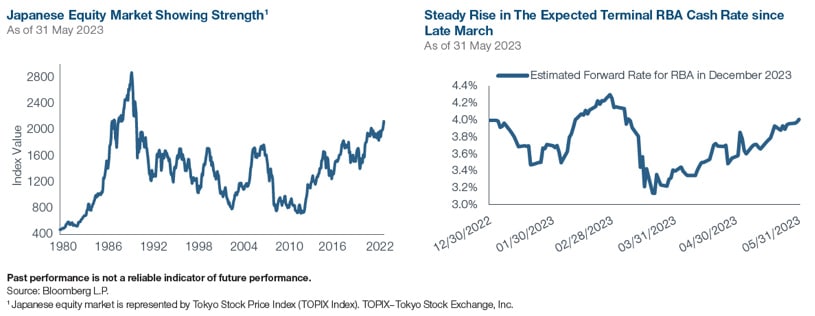
Global Asset Allocation Viewpoints and Investment Environment by T. Rowe Price Australia Investment Committee, as at 31 May 2023.
MARKET PERSPECTIVE
- Macroeconomic outlook remains mixed as data has been surprising to the upside, despite evidence of tightening financial conditions that are still expected to weigh on economic growth in the back half of the year.
- Widening gap in monetary policy likely ahead as the Federal Reserve (Fed) is expected to pause, as is the Reserve Bank of Australia, while the European Central Bank and Bank of England remain hawkish. Meanwhile increased uncertainty around Bank of Japan persists under new leadership as they evaluate yield curve control policy.
- Key risks to global markets include a deeper than expected decline in growth, central bank missteps, persistent inflation, and geopolitical tensions.
Also Read: When Markets Twist and Turn, Flex Your Fixed Income
MARKET THEMES
Back in Business
With the Japanese equity market trading near 30-year highs, investors are questioning if it has staying power this time. Japan has been on a long climb back since their “asset bubble” burst in the early 1990’s and were hampered by decades of weak growth and low inflation. However, today does seem different, underpinned by both structural changes and cyclical tailwinds, with inflation finally showing up–a good problem for Japan, unlike others–that can help stimulate consumption through higher wages. Corporate governance reforms, a key part of “Abenomics,” are also starting to show real progress in improving shareholder value through higher buybacks and dividends.
A weaker yen, pent-up demand from reopening, record foreign inflows and still relatively cheap valuations have been strong tailwinds. Despite the optimism surrounding Japan’s comeback, the months ahead will be closely watched as the more cyclically oriented economy navigates slower global growth and the Bank of Japan looks to unwind ultra-easy policy. For now, though, Japan looks back in business.
What if?
Our base case remains that the Reserve Bank of Australia (RBA) is getting close to the end of its tightening cycle despite recent market re-pricing.
Wage growth inflation should be contained due to an influx of migration, growing the population by 1% per year at the current rate. Moreover, mortgages are still being reset: the RBA estimates that scheduled loan repayments will increase by end-2024 to levels not seen in the past 20 years. This suggests an economic slowdown and a reason for the RBA to re-consider their recent hawkish tone. What is the likely scenario if our base case doesn’t materialize? We think that the risks are on the upside for the economy which would lead to further rate hikes in the coming months. In fact, house prices appeared to have already bottomed at levels higher than in the pre-COVID period. Perhaps unnoticed, the main beneficiary in terms of higher income has been the lower income earners. So, the upside risk for the Australian economy is that households turn out to be more resilient to digesting higher mortgage payments.
The economy could then re-accelerate from here, leading the RBA to be much more hawkish than current market pricing. We could return to an environment where Australian assets would be again seen as a high carry play, akin to the early part of the 2010s period. This is the “What if” scenario that we believe investors should start to prepare for.
PORTFOLIO POSITIONING
- While we maintain a cautious stance with an underweight to equities in favor of fixed income, we decided to rebalance our portfolio and used some cash to buy equities. We still think that equities remain vulnerable to a slowing economy and weaker earnings backdrop, while central banks’ bias, albeit moderating, toward inflation fighting remains a potential headwind to bonds. However, we recognize the recent price action in equities and would like to reduce our active risk through re-risking the portfolio.
- Within equities, we reduced our underweight to the U.S. and European stocks as unrealistic expectations have partly been adjusted and investors are seeking secular growth trends, like artificial intelligence (AI), amid weakening economic backdrop. We are also adding to our overweight in Japanese stocks with our conviction growing on the back of an accommodative central bank, modest reflation, and solid corporate governance reform. This was funded at the expense of Emerging Market stocks where our conviction on the China recovery was eroded based on the most recent economic and sentiment data.
- Within fixed income, we added to Australian duration with a view that the future economic slowdown will start to weigh on long term yields. Additionally, we increased our overweight to long-term U.S. Treasuries as a risk hedge and on expectations that rates have peaked in this cycle.
Note: T. Rowe Price’s Australia Investment Committee comprises local and global investment professionals who apply views from the firm’s Global Asset Allocation Committee to make informed asset allocation views from an Australian investor perspective. The Committee is led by Thomas Poullaouec, Head of Multi-Asset Solutions APAC, based in Singapore.


































